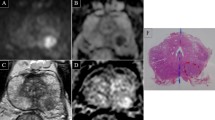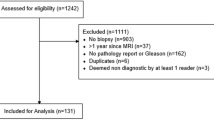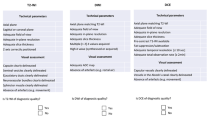Abstract
Purpose
Compare reader performance when adding the Hybrid Multidimensional-MRI (HM-MRI) map to multiparametric MRI (mpMRI+HM-MRI) versus mpMRI alone and inter-reader agreement in diagnosing clinically significant prostate cancers (CSPCa).
Methods
All 61 patients who underwent mpMRI (T2-, diffusion-weighted (DWI), and contrast-enhanced scans) and HM-MRI (with multiple TE/b-value combinations) before prostatectomy or MRI-fused-transrectal ultrasound-guided biopsy between August, 2012 and February, 2020, were retrospectively analyzed. Two experienced readers (R1, R2) and two less-experienced readers (less than 6-year MRI prostate experience) (R3, R4) interpreted mpMRI without/with HM-MRI in the same sitting. Readers recorded the PI-RADS 3-5 score, lesion location, and change in score after adding HM-MRI. Each radiologist’s mpMRI+HM-MRI and mpMRI performance measures (AUC, sensitivity, specificity, PPV, NPV, and accuracy) based on pathology, and Fleiss’ kappa inter-reader agreement was calculated and compared.
Results
Per-sextant R3 and R4 mpMRI+HM-MRI accuracy (82% 81% vs. 77%, 71%; p=.006, <.001) and specificity (89%, 88% vs. 84%, 75%; p=.009, <.001) were higher than with mpMRI. Per-patient R4 mpMRI+HM-MRI specificity improved (48% from 7%; p<.001). R1 and R2 mpMRI+HM-MRI specificity per-sextant (80%, 93% vs. 81%, 93%; p=.51,>.99) and per-patient (37%, 41% vs. 48%, 37%; p=.16, .57) remained similar to mpMRI. R1 and R2 per-patient AUC with mpMRI+HM-MRI (0.63, 0.64 vs. 0.67, 0.61; p=.33, .36) remained similar to mpMRI, but R3 and R4 mpMRI+HM-MRI AUC (0.73, 0.62) approached R1 and R2 AUC. Per-patient inter-reader agreement, mpMRI+HM-MRI Fleiss Kappa, was higher than mpMRI (0.36 [95% CI 0.26, 0.46] vs. 0.17 [95% CI 0.07, 0.27]); p=.009).
Conclusion
Adding HM-MRI to mpMRI (mpMRI+HM-MRI) improved specificity and accuracy for less-experienced readers, improving overall inter-reader agreement.
Graphical Abstract





Similar content being viewed by others
Abbreviations
- ADC:
-
Apparent diffusion coefficient
- CAD:
-
Computer-aided diagnosis
- CSPCa:
-
Clinically significant prostate cancer
- AUC:
-
Area under the receiver operating characteristic curve
- DCE:
-
Dynamic contrast enhancement
- DWI:
-
Diffusion-weighted imaging
- HM-MRI:
-
Hybrid multidimensional-MRI
- MpMRI:
-
Multiparametric MRI
- PI-RADS:
-
Prostate Imaging Reporting and Data System
- PPV:
-
Positive predictive value
- NPV:
-
Negative predictive value
- PSA:
-
Prostate-specific antigen
- TRUS:
-
Transrectal US
References
Siegel R, Miller K, Fuchs H, et al. Cancer Statistics 2022. Ca Cancer J Clin 2022; 72: 7-33 https://doi.org/10.3322/caac.21708
Padhani A, Barentsz J, Villeirs G, Rosenkrantz A, Margolis D, Turkbey B, et al. PI-RADS steering committee: the PI-RADS multiparametric MRI and MRI-directed biopsy pathway. Radiology 2019; 292(2): 464–474. https://doi:https://doi.org/10.1148/radiol.2019182946
Fütterer JJ, Briganti A, De Visschere P, Emberton M, Giannarini G, Kirkham A, Taneja SS, Thoeny H, Villeirs G, Villers A. Can clinically significant prostate cancer be detected with multiparametric magnetic resonance imaging?a systematic review of the literature.Eur.Urol.2015;68(6):1045–1053. https://doi:https://doi.org/10.1016/j.eururo.2015.01.013
Westphalen A, McCulloch C, Anaokar J, Arora S, Barashi N, et al. Variability of the positive predictive value of PI-RADS for prostate MRI across 26 centers: experience of the Society of Abdominal Radiology Prostate Cancer Disease-focused Panel. Radiology 2020; 296(1):76–84. https://doi:https://doi.org/10.1148/radiol.2020190646
Rosenkrantz A, Ginocchio L, Cornfeld D, Froemming A, Gupta R, Turkbey B, Westhpalen A, Babb J, Margolis D. Interobserver reproducibility of the PI-RADS version 2 lexicon: a multicenter study of six experienced prostate radiologists. Radiology 2016; 280 (3): 793-804. https://doi.org/10.1148/radiol.2016152542
Youn SY, Choi MH, Kim DH, Lee YJ, Huisman H, Johnson E, ... & Kamen A. Detection and PI-RADS classification of focal lesions in prostate MRI: performance comparison between a deep learning-based algorithm (DLA) and radiologists with various levels of experience. European Journal of Radiology 2021; 142: 109894 https://doi.org/10.1016/j.ejrad.2021.109894
Greer MD, Lay, N, Shih JH, Barrett T, Bittencourt LK, Borofsky S, Kabakus I, Law YM, Marko J, Shebel H, et al. Computer-aided diagnosis prior to conventional interpretation of prostate mpMRI: an international multi-reader study. Eur. Radiol. 2018; 28(10): 4407–4417. https://doi:https://doi.org/10.1007/s00330-018-5374-6
Faiella E, Vertulli D, Esperto F, Cordelli E, Soda P, Muraca RM, Moramarco LP, Grasso RF, Zobel BB, Santucci D. Quantib prostate compared to an expert radiologist for the diagnosis of prostate cancer on mpMRI: a singlecenter preliminary study. Tomography 2022; 8(4): 2010-2019. https://doi:https://doi.org/10.3390/tomography 8040168
Giannini V, Mazzetti S, Cappello G, Doronzio VM, Vassallo L, Russo F, Giacobbe A, Muto G, Regge D. Computer-aided diagnosis improves the detection of clinically significant prostate cancer on multiparametric-MRI: a multi-observer performance study involving inexperienced readers. Diagnostics 2021; 11(6): 973. https://doi:https://doi.org/10.3390/diagnostics11060973
Gaur S, Lay N, Harmon SA, Doddakashi S, Mehralivand S, Argun B, Barrett T, Bednarova S, Girometti R, Karaarslan E, Kural AR, Oto A, Purysko AS, Antic T, Magi-Galluzzi C, Saglican Y, Sioletic S, Warren AY, Bittencourt L, Fütterer JJ, Gupta RT, Kabakus I, Law YM, Margolis DJ, Shebel H, Westphalen AC, Wood BJ, Pinto PA, Shih JH, Choyke PL, Summers RM, Turkbey B. Can computer-aided diagnosis assist in the identification of prostate cancer on prostate MRI? a multi-center, multi-reader investigation. Oncotarget 2018; 9(73):33804-33817 https://doi.org/10.18632/oncotarget.26100
Hambrock T, Vos PC, De Kaa CAH, Barentsz JO, Huisman H. Prostate cancer: computer-aided diagnosis with multiparametric 3-T MR imaging—effect on observer performance. Radiology 2013; 266:521–530 https://doi.org/10.1148/radiol/12111634
Chatterjee A, Bourne R, Wang S, Devaraj A, Gallan A, Antic T, Karczmar G, Oto A. Diagnosis of prostate cancer with noninvasive estimation of prostate tissue composition by using hybrid multidimensional MR imaging: a feasibility study. Radiology 2018; 287:864–873 https://doi.org/10.1148/radiol.2018171130
Wang S, Peng Y, Medved M, Yousuf A, Ivancevic M, Karademir I, Jiang Y, Antic T, Sammet S, Oto A, Karczmar G. Hybrid multidimensional T2 and diffusion-weighted MRI for prostate cancer detection. J. Magn. Reson. Imaging 2014; 39:781-788 https://doi.org/10.1002/jmri.24212
Chatterjee A, Watson G, Myint E, Sved P, McEntee M, Bourne R. Changes in epithelium, stroma, and lumen space correlate more strongly with Gleason pattern and are stronger predictors of prostate ADC changes than cellularity metrics. Radiology 2015; 277: 751-762 https://doi.org/10.1148/radiol.2015142414
Sabouri S, Chang S, Savdie R, Zhang J, Jones E, Goldenberg S, Black P, Kozlowski P. Luminal water imaging: a new MR imaging T2 mapping technique for prostate cancer diagnosis. Radiology 2017; 284:451–459. https://doi.org/https://doi.org/10.1148/radiol.2017161687
Zhang Z, Wu H, Priester A, Magyar C, Mirak SA, Shakeri S, Bajgiran AM, Hosseiny M, Azadikhah A, Sung K, Reiter R, Sisk A, Raman S, Enzmann D. Prostate microstructure in prostate cancer using 3-T MRI with diffusionrelaxation correlation spectrum imaging: validation with whole-mount digital histopathology. Radiology 2020; 296:348–355. https://doi.org/https://doi.org/10.1148/radiol.2020192330
Johnston E, Bonet-Carne E, Ferizi U, Yvernault B, Pye H, Patel D, Clemente J, Piga W, Heavey S, Sidhu H, Giganti F, O’Callaghan J, ……. Punwani S. VERDICT MRI for prostate cancer: intracellular volume fraction versus apparent diffusion coefficient. Radiology 2019; 291:391–397. https://doi.org/10.1148/radiol.2019181749
Panagiotaki E,Chan R,Dikaios N, Ahmed H, O’Callaghan J, Freeman A, Atkinson D, Punwani S, Hawkes D, Alexander D. Microstructural characterization of normal and malignant human prostate tissue with vascular, extracellular, and restricted diffusion for cytometry in tumors magnetic resonance imaging. Investigative Radiology 2015; 50(4):218-227. https://doi:https://doi.org/10.1097/RLI.0000000000000115
Hectors S, Said D, Gnerre J, Tewari A, Touli B. Luminal water imaging: comparison with diffusion-weighted imaging (DWI) and PI-RADS for characterization of prostate cancer aggressiveness. J. MAGN. RESON. IMAGING 2020; 52: 271–279. https://doi.org/https://doi.org/10.1007/s00330-020-06675-2
McCammack KC, Kane CJ, Parsons JK, White NS, Schenker-Ahmed NM, Kuperman JM, Bartsch H, Desikan RS, Rakow-Penner RA, Adams D, Liss MA, Mattrey RF, Bradley WG, Margolis DJA, Raman SS, Shabaik A, Dale AM, and Karow DS. In vivo prostate cancer detection and grading using restriction spectrum imaging-MRI. Prostate Cancer and Prostatic Diseases 2016; 19(2):168 – 173. https://doi.org/https://doi.org/10.1038/pcan.2015.61
Chatterjee A, Mercado C, Bourne RM, et al. Validation of prostate tissue composition by using hybrid multidimensional MRI: correlation with histologic findings. Radiology 2022; 302(2):368-77. https://doi.org/https://doi.org/10.1148/radiol.2021204459
Chatterjee A., Antic T, Gallan AJ, et al. Histological validation of prostate tissue composition measurement using hybrid multi-dimensional MRI: agreement with pathologists’ measures. Abdom Radiol 2022; 47:801–813 https://doi.org/10.1007/s00261-021-03371-7
Lee GH, Chatterjee A, Karademir I, Engelmann R, Yousuf A, Giurcanu M, ... & Oto A. Comparing radiologist performance in diagnosing clinically significant prostate cancer with multiparametric versus hybrid multidimensional MRI. Radiology 2022; 305(2):399-407 https://doi.org/10.1148/radiol.211895
Stock C, Hielscher T (2014) DTComPair: Comparison of binary diagnostic tests in a paired study design. R package version 1(3). https://cran.microsoft.com/web/packages/DTComPair/DTComPair.pdf
Efron B (1992) Bootstrap Methods: Another Look at the Jackknife. In: Kotz S, Johnson NL (eds) Breakthroughs in statistics. Springer Series in Statistics. Springer, New York, pp 1-26.
Saravanan V, Berman GJ, & Sober SJ. (2020). Application of the hierarchical bootstrap to multi-level data in neuroscience. Neurons, Behavior, Data Analysis and Theory 2020; 3(5). https://nbdt.scholasticahq.com/article/13927application-of-the-hierarchical-bootstrap-to-multi-level-data-in-neuroscience
Sun C, Chatterjee A, Yousuf A, Antic T, Eggener S, Karczmar GS, Oto A. Comparison of T2-weighted imaging, DWI, and dynamic contrast-enhanced MRI for calculation of prostate cancer index lesion volume; correlation with whole-mount pathology, American Journal of Roentgenology 2019; 212(2): 351-356. https://doi.https://doi.org/10.2214/AJR.18.20147
Gundogdu B, Pittman J, Chatterjee A, Szasz T, Lee G, Giurcanu M, Medved M, Engelmann R, Guo Xiaodong, Yousuf A, Antic T, Devarag A, Fan X, Oto A, Karczmar G. Directional and inter-acquisition variability in diffusionweighted imaging and editing for restricted diffusion, Magnetic Resonance in Medicine 2022, 88: 2298-2310. https://doi.org/https://doi.org/10.1002/mrm.29385
Drost FH, Osses D, Nieboer D, et al. Prostate magnetic resonance imaging, with or without magnetic resonance imaging-targeted biopsy, and systematic biopsy for detecting prostate cancer: a cochrane systematic review and meta-analysis. Eur Urol 2020; 77: 78–94. https://doi.org/https://doi.org/10.1016/j.eururo.2019.06.023
Ahmed HU, El-Shater Bosaily A, Brown LC, et al. Diagnostic accuracy of multiparametric MRI and TRUS biopsy in prostate cancer (PROMIS): a paired validating confirmatory study. Lancet 2017; 389:815-822. https://doi.org/https://doi.org/10.1016/S0140-6736(16)32401-1
Becerra MF, Alameddine M, Zucker I, Tamariz L, Palacio A, Nemeth Z, Velasquez MC, Savio LF, Panizzutti M, Jue JS, Soodana-Prakash N, Ritch CR, Gonzalgo ML, Parekh DJ, Punnen S. Performance of multiparametric MRI of the prostate in biopsy naïve men: a meta-analysis of prospective studies. Urology 2020; 146:189-195 https://doi.org/10.1016/j.urology.2020.06.102
Mazzone E, Stabile A, Pellegrino F, Basile G, Cignoli D, Cirulli GO, ... & Briganti A. Positive predictive value of Prostate Imaging Reporting and Data System version 2 for the detection of clinically significant prostate cancer: a systematic review and meta-analysis. European urology oncology 2021; 4(5): 697-713. https://doi:https://doi.org/10.1016/j.euro.2020.12.004
Hietikko R, Kilpeläinen TP, Kenttämies A, Ronkainen J, Ijäs K, Lind K, Marjasuo S, Oksala J, Oksanen O, Saarinen T, et al. Expected impact of MRI-related interreader variability on ProScreen prostate cancer screening trial: a pre-trial validation study. Cancer Imaging 2020; 20(1): 1-8, 72 https://doi.org/10.1186/s40644-020-00351-w
Author information
Authors and Affiliations
Corresponding author
Ethics declarations
Conflict of interest
Drs Aytekin Oto, Aritrick Chatterjee, and Gregory Karczmar report equity in QMIS LLC, outside the submitted work.
Ethical approval
All procedures performed in studies involving human participants were in accordance with the University of Chicago Institutional Review Board.
Consent to participations
Informed consent was obtained from all individual participants included in the study.
Consent for publications
All co-authors are aware of submission of this work and they approved the submission.
Additional information
Publisher's Note
Springer Nature remains neutral with regard to jurisdictional claims in published maps and institutional affiliations.
Supplementary Information
Below is the link to the electronic supplementary material.
Rights and permissions
Springer Nature or its licensor (e.g. a society or other partner) holds exclusive rights to this article under a publishing agreement with the author(s) or other rightsholder(s); author self-archiving of the accepted manuscript version of this article is solely governed by the terms of such publishing agreement and applicable law.
About this article
Cite this article
Lee, G., Chatterjee, A., Harmath, C. et al. Improving reader accuracy and specificity with the addition of hybrid multidimensional-MRI to multiparametric-MRI in diagnosing clinically significant prostate cancers. Abdom Radiol 48, 3216–3228 (2023). https://doi.org/10.1007/s00261-023-03969-z
Received:
Revised:
Accepted:
Published:
Issue Date:
DOI: https://doi.org/10.1007/s00261-023-03969-z




